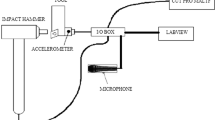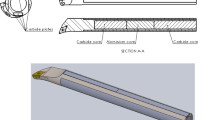Abstract
The aim of the experimental investigations was to select the optimal proposed cutting tool geometry by studying the effects of the tool angles (tool back rake angle (γ p )) and the cutting edge angles (the tool cutting edge angle of the major cutting edge (κ r ) and cutting edge inclination angle (λ s )) and there interrelations, which produces less-generated cutting forces, less tool vibrations, and improved machined surface roughness for turning operations. Different cutting tool geometries were designed according to the main tool angles and manufactured with a high speed steel material (HSS) type-T15 with a high tungsten alloy grade. Based on measured cutting force components, tool vibrations, and surface roughness, it can be concluded that when the γ p angle ranges from a negative value (γ p = −5°) to a positive value (γ p = 0° and γ p = 5°), the average cutting force components decreased, especially tangential force component (Fz) that was more remarkable, and tool vibrations reduced; this decreasing trend improved surface roughness. The effects of the variation of the κ r angle and the positive λ s angle were observed on the variation of the axial and radial force component, whereas the tangential force remained constant. Lowering κ r decreased the surface roughness, while the λ s angle increased, a small variation was observed. As a conclusion, the good optimized cutting tool geometries were classified as follows: the first was cutting tool geometry having a neutral angle (γ p = 0°), the second was with γ p = +5°, and then the third was with γ p = −5°. Thereafter, the fourth tool geometry was having λ s = 3° and the last was for geometry having κ r = 75°.
Similar content being viewed by others
References
Astakhov VP (2010) Fundamentals of the selection of cutting tool geometry parameters. Springer, London, pp 127–204
Günay M, Korkut I, Aslan E, Seker U (2005) Experimental investigation of the effect of cutting tool rake angle on main cutting force. J Mater Process Technol 166:44–49
Günay M, Aslan E, Korkut I, Seker U (2004) Investigation of the effect of rake angle on main cutting force. Int J Mach Tools Manuf 44:953–959
Günay M, Seker U (2006) Design and construction of a dynamometer to evaluate the influence of cutting tool rake angle on cutting forces. Mater Des 27:1097–1101
Saglam H, Yaldiz S, Unsacar F (2007) The effect of tool geometry and cutting speed on main cutting force and tool tip temperature. Mater Des 28:101–111
Neseli S, Yaldız S, Turkes E (2011) Optimization of tool geometry parameters for turning operations based on the response surface methodology. Measurement 44:580–587
Saglam H, Unsacar F, Yaldiz S (2006) Investigation of the effect of rake angle and approaching angle on main cutting force and tool tip temperature. Int J Mach Tools Manuf 46:132–141
Mei Z, Yang S, Shi H, Chang S, Ehmann KF (1994) Active chatter suppression by on-line variation of the rake and clearance angles in turning-principles and experimental investigations. Int J Mach Tools Manuf 34(7):981–990
Luo X, Cheng K, Ward R (2005) The effects of machining process variables and tooling characterisation on the surface generation. Int J Adv Manuf Technol 25:1089–1097
Huang Y, Liang SY (2003) Force modeling in shallow cuts with larger negative and large nose radius tools—applications to hard turning. Int J Adv Manuf Technol 22:626–632
Dimla DE Sr (2002) The correlation of vibration signal features to cutting tool wear in a metal turning operation. Int J Adv Manuf Technol 19:705–713
Lin SC, Chang MF (1998) A study on the effects of vibrations on the surface finish using a surface topography simulation model for turning. Int J Mach Tools Manuf 38:763–782
Abuthakeer SS, Mohanram PV, MohanKumar G (2011) Prediction and control of tool vibration in CNC lathe with Anova and Ann. Int J Lean Think 2(1):1–23
Lee LC, Lee KS, Gan CS (1989) On the correlation between dynamic cutting force and tool wear. Int J Mach Tools Manuf 29(3):295–303
Qin F, Gong X, Chou K (2011) Size effects in cutting with a diamond-coated tool. Proceedings of the ASME 2011 International Manufacturing Science and Engineering Conference, MSEC2011-50234, V1:267-273. Oregon, USA
Dimla DE Sr, Lister PM (2000) On-line metal cutting tool condition monitoring: I: force and vibration analyses. Int J Mach Tools Manuf 40:739–768
Author information
Authors and Affiliations
Corresponding author
Rights and permissions
About this article
Cite this article
Abainia, S., Ouelaa, N. Experimental study of the combined influence of the tool geometry parameters on the cutting forces and tool vibrations. Int J Adv Manuf Technol 79, 1127–1138 (2015). https://doi.org/10.1007/s00170-015-6885-9
Received:
Accepted:
Published:
Issue Date:
DOI: https://doi.org/10.1007/s00170-015-6885-9




